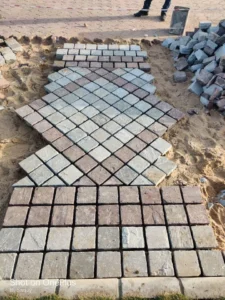Unlocking the Secrets of Cobblestones: Unveiling the Types of Rocks Used in Their Creation
Subheading: The Allure of Cobblestone
The charming, old-world appeal of cobblestone streets and buildings has a timeless beauty that continues to enchant us. These carefully arranged stones, often molded by nature and time, carry stories of human civilization from ancient eras. The term “cobblestone” is derived from the English word “cob,” meaning a rounded lump, perfectly describing the rounded, naturally weathered stones known for their durability and aesthetics.
Subheading: The Geological Aspects of Cobblestones
Cobblestones are not a specific type of rock; rather, they refer to the size and application of the stone. In geological terms, a cobblestone is a fragment of rock defined by its size, which typically ranges from 64 to 256 millimeters in diameter. The types of rocks used as cobblestones can vary greatly depending on the region and availability of local resources.
What rock is used for cobblestone?
Subheading: Common Types of Rocks Used in Cobblestones
Granite: Arguably the most common rock type used for cobblestones, granite, is chosen for its incredible durability, strength, and resistance to weathering. These characteristics make it an excellent choice for high-traffic areas, as it withstands wear and tear remarkably well.
Basalt: Basalt, a type of volcanic rock, is often used for cobblestones, particularly in regions where it’s readily available. It is highly durable and resistant to wear, making it another excellent choice for cobblestone streets.
Sandstone and Limestone: In some regions, sedimentary rocks such as sandstone and limestone are used as cobblestones. While not as hard as granite or basalt, these rocks offer a wider range of colors and textures, making them an appealing choice for decorative applications.
Subheading: The Timeless Appeal of Cobblestones
The choice of rock used in cobblestones can impact their appearance, longevity, and even the sound they make underfoot or vehicle tires. The use of locally available rock types for cobblestones also gives regions their distinctive charm and reflects the geological history of the area. For instance, granite cobblestones are a common sight in many older North American and European cities, while basalt cobblestones are common in certain volcanic regions.
Subheading: In Conclusion
While the type of rock used can vary, cobblestones are usually composed of tough, weather-resistant rocks like granite and basalt, as well as sandstone and limestone in some areas. The choice of rock contributes not only to the durability of cobblestone constructions but also their unique aesthetics that have captivated humans for centuries. Whether walking on a historic cobblestone street or admiring a cobblestone building, one is stepping on or touching a piece of Earth’s fascinating geological history.

